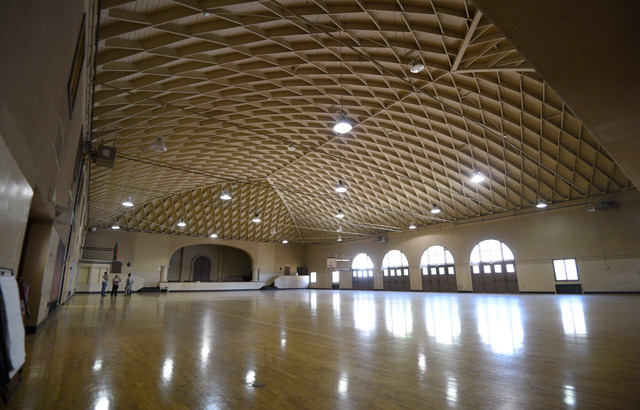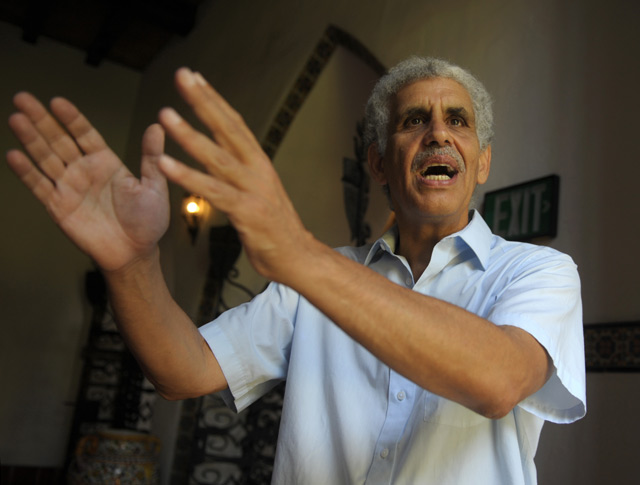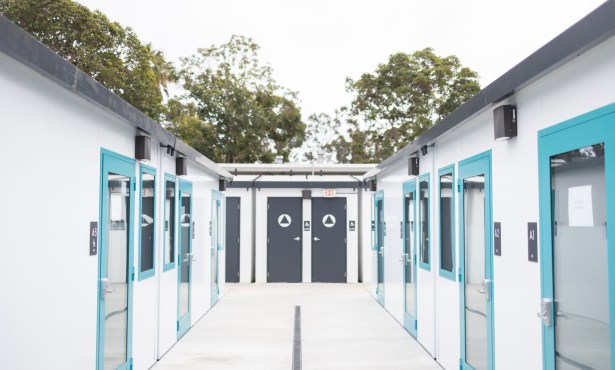School Bond Measures Include Armory Purchase
Measures I and J Would Also Cover $200 Million of Campus Upgrades and Repairs

When it comes to Santa Barbara schools, voters this fall are facing a considerable checklist that not only includes mundane necessities — all-new roofs, water pipes, classrooms, etc. — but also the singular opportunity to purchase the California National Guard Armory, a roughly 30,000-square-foot facility on 4.7 downtown acres.
To pay for it all, the Santa Barbara Unified School District has put a pair of bond measures on the November ballot. Measure J seeks $58 million for the district’s 13 elementary schools, where the spectrum of repairs and upgrades range from lead paint and asbestos removal to technologically updated science labs to the replacement of worn-out portables, some of which have been in steady use for decades. The much bigger ask is Measure I. It calls for $135 million for the district’s four junior highs and five high schools — also in need of new classrooms and plumbing and electrical upgrades — with $20 million earmarked for the purchase and renovation of the armory on Canon Perdido Street.
While fiscally conservative watchdogs point out that the bump in property taxes to pay for the bonds — estimated at $11.49 per $100,000 of assessed value for Measure I and $13.15 for Measure J — further exasperates cost-of-living challenges for property owners and renters in the district, proponents wince at deteriorating classrooms and cheer the prospect of opening the armory to students and the greater South Coast community.

Prime Real Estate
Located next door to the Boys & Girls Club, and covering an entire city block between Santa Barbara High School and Santa Barbara Junior High, the armory arose out of the Great Depression and President Roosevelt’s New Deal. In 1935, the city approved the $16,000 bond purchase of the land, and a municipal election sold it to the state for $1 as millions in federal funds came to town for a host of construction projects, including the armory, the Santa Barbara Bowl, and a sewer system on the Mesa, among others. Then-senator Thomas Storke is credited with wrangling an additional $110,000 for the armory, bringing its total construction cost to $176,495, according to city documents. Its Spanish Colonial Revival style, designed by architectural firm Edwards and Plunkett — also responsible for the Arlington Theatre, Santa Barbara Woman’s Club, and the airport’s former main terminal — defied Art Deco trends of the 1930s.
The L-shaped main building measures more than 28,000 square feet, and the two rectangular outbuildings — both with Mission Revival tile roofs — bring the footprint up another 9,000 square feet, give or take. The main building’s auditorium features nearly 12,000 square feet of maple flooring beneath a barrel-vaulted ceiling in a repeating diamond pattern of short timbers called lamellas. From the auditorium’s southwestern corner rises a four-story watchtower with recessed French windows and balconies at the cardinal compass points.
During World War II, the armory served as an assembly plant for Lockheed Aviation. Since then, the space — while maintained as a one-weekend-a-month training facility for dozens of guardsmen — has hosted movies, concerts, dances, sports, and quinceañeras. Assigned with maintaining order, quelling disorder, and protecting property, Santa Barbara guardsmen were called on during the Watts and Isla Vista riots in the 1960s.
In 1998, city officials designated landmark status to the main armory building and its now-withered Santa Barbara Armory Memorial Rose Garden. Efforts to fold the property into the school system date back at least that far, building momentum over the years as the impression of it as an underused ghost town gained traction, only briefly disrupted by weekend training stints and the small team of full-time guardsmen tasked with maintaining and repairing army vehicles in one of the historic outbuildings.
“What remained frustrating to me was that the armory seemed to be serving no purpose,” remembered retired school superintendent David Cash, who first started looking into armory acquisition in 2011. “Nobody could express to me how that building and those activities were serving the citizens of California.” During multiple trips and calls to Sacramento, Cash said he found no interest from the state at meeting the school district even halfway. “Getting to this point was arduous,” he said, adding that the district and the city were further dismayed when legislation last year cleared the way for the state to sell off some of its armories, including Santa Barbara’s. But nobody in Sacramento called Santa Barbara to offer a heads-up.
Assemblymember Das Williams responded with a piece of legislation giving the district first dibs on the armory, at fair market value. While Governor Brown signed the legislation into law just last week, the school district has been prepping its bond measure since the spring, and an appraisal of the armory is now in the works by Alison Moore, a longtime Santa Barbara resident and former Santa Barbara Bank & Trust chief review appraiser now in private practice. “It’s a complex appraisal, in terms of historical significance and development options,” she said.
While Cash envisioned the armory’s transformation into a home for vocational training — it already has an auto shop, for instance — in line with a Career Technical Education grant secured by the district during the 2015-16 school year, Williams’s press release included recreational use and after-school programs. “There are myriad opportunities for collaboration with this building,” Williams said.
“This has all happened so fast,” said school boardmember Kate Parker, who is working on the bond campaign as a private citizen. She said the focus is on first purchasing the armory, then circling back to the community for input on what to do with it. “We would see it as a resource for the entire South Coast,” Parker said. Also, proponents add, approval of I and J would allow the district to apply for matching state grants.
But that’s putting the cart before the horse, according to Lou Segal, an investor who ran for school board in 2012. “How do you come up with the $20 million cost when there has never been any study to determine what it will be used for or how much it will cost? The acquisition plan might have some merit, but before it is approved by taxpayers, proponents should have to disclose the good, the bad, and the ugly.”
One concern has been the armory’s abandoned fueling station. “There’s a history of underground [fuel] tanks, with permits indicating removal of several of them,” Moore said. “But we don’t know where they all were.” As she inspects the grounds and wades through 80 years of armory files toward an ultimate valuation, part of Moore’s job is to find out. The state will also be conducting its own appraisal.
Schools of the Future
In the meantime, Measure I champions are also carrying the Measure J torch, $58 million for elementary schools. Beyond portable upgrades and replacements, and the sort of patchwork necessary to maintain any expansive, heavily used property, newly hired Superintendent Cary Matsuoka envisions workspaces of the near future, open ateliers staffed by collaborating instructor groups, a departure from traditional scholastic pictures of one teacher in a box with 30 kids. And with enrollment fairly stable, Parker said, the bulk of the funding generated by successful measures isn’t about expansion. “This is not wanting to have a bigger kitchen table for all the kids,” she said. “This is about asking for a modernized kitchen table with 21st-century amenities.”
Measures I and J are separate ballot items, each needing 55 percent voter approval to pass. The election is on November 8.



